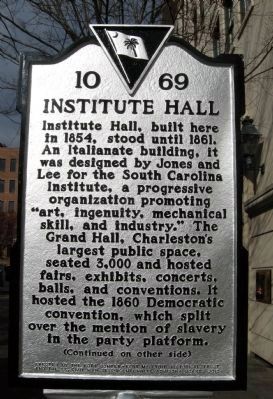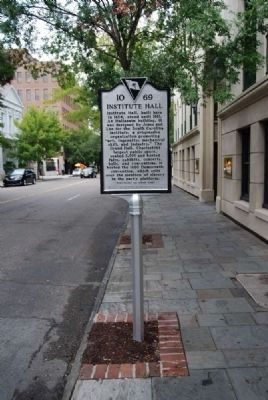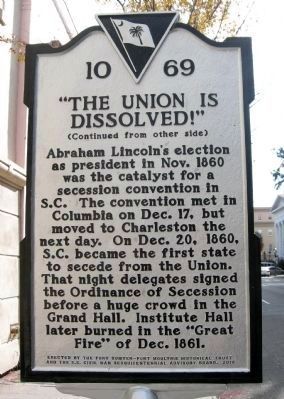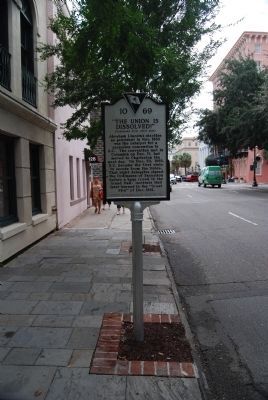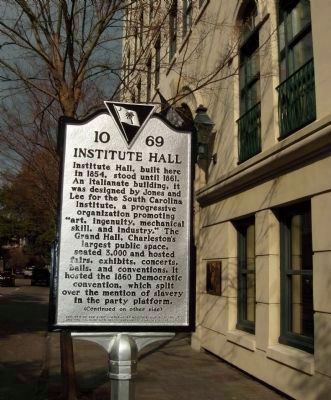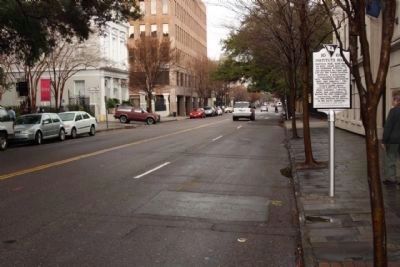French Quarter in Charleston in Charleston County, South Carolina — The American South (South Atlantic)
Institute Hall / "The Union Is Dissolved!"
Inscription.
Erected 2010 by Fort Sumter-Fort Moultrie Historical Trust and the S.C. Civil War Sesquicentennial Advisory Board. (Marker Number 10-69.)
Topics. This historical marker is listed in these topic lists: Architecture • War, US Civil. A significant historical date for this entry is December 20, 1860.
Location. 32° 46.704′ N, 79° 55.873′ W. Marker is in Charleston, South Carolina, in Charleston County. It is in the French Quarter. Marker is on Meeting Street south of Cumberland Street, on the left when traveling south. Touch for map. Marker is at or near this postal address: 134 Meeting Street, Charleston SC 29401, United States of America. Touch for directions.
Other nearby markers. At least 10 other markers are within walking distance of this marker. Ordinance of Secession (here, next to this marker); Carolina Art Association / James S. Gibbes Memorial Art Gallery (within shouting distance of this marker); Josiah Flagg (within shouting distance of this marker); Charleston Gas Light Company (within shouting distance of this marker); Burger's Tavern (within shouting distance of this marker); The Independent or Congregational Church of Charlestown (within shouting distance of this marker); 54 Queen Street (about 300 feet away, measured in a direct line); Hibernian Hall (about 400 feet away); Fireproof Building (about 400 feet away); Richard Hutson (about 500 feet away). Touch for a list and map of all markers in Charleston.
Also see . . .
1. 1860 Democratic National Convention. The 1860 Democratic National Convention was one of the crucial events in the lead-up to the American Civil War. (Submitted on October 1, 2011, by Brian Scott of Anderson, South Carolina.)
2. Ordinance of secession. The Ordinance of Secession was the document drafted and ratified in 1860 and 1861 by the states officially seceding from the United States of America. (Submitted on October 1, 2011, by Brian Scott of Anderson, South Carolina.)
Additional commentary.
1. Text of the South Carolina Ordinance of Secession
The State of South Carolina
At a Convention of the People of the State of South Carolina, begun and holden at Columbia on the Seventeenth day of December in the year or our Lord one thousand eight hundred and sixty and thence continued by adjournment to Charleston, and there by divers adjournments to the Twentieth day of December in the same year –
An Ordinance To dissolve the Union between the State of South Carolina and other States united with her under the compact entitled “The Constitution of the United States of America.”
We, the People of the State of South Carolina, in Convention assembled do declare and ordain, and it is herby declared and ordained, That the Ordinance adopted by us in Convention, on the twenty-third day of May in the year of our Lord One Thousand Seven hundred and eight eight, whereby the Constitution of the United State of America was ratified, and also all Acts and parts of Acts of the General Assembly of this State, ratifying amendment
of the said Constitution, are here by repealed; and that the union now subsisting between South Carolina and other States, under the name of “The United States of America,” is hereby dissolved.
Done at Charleston, the twentieth day of December, in the year of our Lord one thousand eight hundred and sixty.
[signed] D.F. Jamison Delegate from Barnwell and President of the Convention
[signatures of delegates to the convention]
Attest: Benj. J. Arthur, Clerk of the Convention
— Submitted October 1, 2011, by Brian Scott of Anderson, South Carolina.
2. An Account of the "Great Fire" of 1861 (New York Times, December 18, 1861)
The fire broke out at about 9 o'clock in the evening of the 11th inst., in Russell & Olds' sash and blind factory, at the foot of Hazel-street, extending to the machine shop of Cameron & Co. Before midnight the fire had assumed an appalling magnitude, and Meeting-street, from Market to Queen, was one mass of flame. As tenement after tenement was enveloped in flames, the panic became awful, and thousands of families evacuated their houses and filled the streets. The buildings in the lower part of the city, where the fire broke out, were principally of wood, and extremely inflammable, which accounts for the remarkably rapid progress of the fire. At midnight the Circular Church and Institute Hall were burning, and the proximity of the flames to the Charleston Hotel and the Mills House, caused them to be evacuated by their inmates.
At 1 o'clock the fire tended more southward, toward the corner of Archdale and Queen streets, to the rear of the Charleston Hotel and to the end of Hayne-street; crossing Market-street, the fire spread down East Bay to Cumberland street, and across to the Mills House, including in its destruction the Circular Church, Institute Hall and the Charleston Hotel. All the buildings on King-street, from Clifford nearly to Broad, were destroyed before 3 o'clock. Gen. Ripley, who superintended the movements of the troops who arrived on the scene at about this time ordered several buildings on the route of the conflagration to be blown up. After some delay the order was executed, but not before the theatre, Floyd's coach factory, opposite the Express office, the old Executive building, and all the houses from this point to Queen-street had caught fire, and were destroyed.
At about 4 o'clock the wind changed the direction of the flames towards Broad-street. Soon after St. Andrew's Hall took fire, and subsequently the cathedral, the spire of which fell shortly after 5 o'clock. The fire made a clear sweep through the city, making its track from East Bay
to King-street.
The Charleston Courier of the 13th inst. gives a list of between 200 and 300 sufferers, and says that the loss is estimated at from five to seven millions of dollars.
A resolution was unanimously adopted by the Confederate Congress, appropriating two hundred and fifty thousand dollars as an advance on account of the claims of South Carolina upon the Confederate States.
We give herewith a diagram of that part of Charleston which has been ravaged by the great fire. All of that section of the city colored black has not been destroyed; but the whole region from Hazel to Broad-street, and from East Bay to the Catholic Cathedral, near Friend-street, seems to have been assaulted with more or less fury by the devouring element.
The papers of the city give a list of 576 buildings which were burnt on Wednesday alone, and estimate the value of the property destroyed as high as seven millions of dollars. This estimate of value is undoubtedly in the usual Carolina style of exaggeration; and the 576 buildings must include a large proportion of ricketty old shells and negro shanties. Still, it is as evident now as it was from the first accounts, that the business and trading parts of the town, and a great part of its public edifices and churches, are in ashes. The number of the latter now given as being destroyed exceeds the number mentioned
in the first reports; but not half the public buildings in the burnt district are enumerated in the dispatch. The list of two or three hundred sufferers alluded to by the telegraph must refer to the property owners alone; for there was a resident population of from seven to ten thousand whites, blacks and mongrels comprised within the burnt district. (In another dispatch, indeed, it is mentioned that thousands of families had evacuated their houses and filled the streets.) The telegrams we had on Saturday said that the fire had crossed Broad-street, and was sweeping southward; but our dispatches to-day make no mention of any ravages south of that street; so that it is likely that it was confined within the limits indicated in our diagram.
Charleston is built on a piece of land very much resembling that part of Manhattan Island on which this City is situated. There is a river on either side, as with us, and the land there as here begins with a narrow point looking out on the bay, and widening as you go up town. Immediately on the Battery there (as used to be the case here) are the residences of the opulent. From these to Broad-street are the houses of middle-class people, many of them wooden -- with the sinks of iniquity and various trading, liquor and junketing shops on the east side, as with us -- only here these are a little higher up. Broad-street, as its name implies,
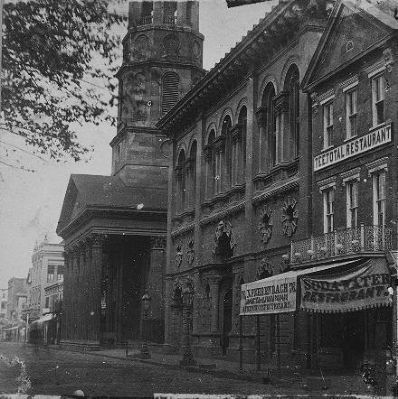
Unknown, courtesy of the New York Historical Society
7. "Institute Hall, where on Dec. 20, 1860 the Ordinance of Secession was ratified"
This undated photograph, the left half of a stereograph, is courtesy of the New York Historical Society, and forms part of the Civil War Treasures of the New York Historical Society collection.
In the photo, some may also find the restaurant next to the Hall of some interest - the "Teetotal Restaurant", with soda water featured prominently on the building's awning.
In the photo, some may also find the restaurant next to the Hall of some interest - the "Teetotal Restaurant", with soda water featured prominently on the building's awning.
— Submitted October 1, 2011, by Brian Scott of Anderson, South Carolina.
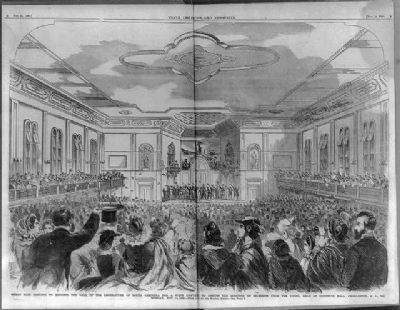
Photographed By Frank Leslie's Illustrated Newspaper, 1860 Nov. 24, p. 8-9., November 24, 1860
8. "Great mass meeting to endorse the call of the legislature of South Carolina...."
This illustration, fully captioned with "Great mass meeting to endorse the call of the legislature of South Carolina for a state conv. to discuss the question of secession from the Union, held at Institute Hall, Charleston, S.C. on Monday, Nov. 12, 1860" appeared in Frankly Leslie's Illustrated Newspaper, a popular newsweekly of the era. Image courtesy of the Library of Congress. (Click on image to enlarge)
Credits. This page was last revised on February 16, 2023. It was originally submitted on December 21, 2010, by Harold Colson of San Diego, California. This page has been viewed 4,997 times since then and 237 times this year. Last updated on December 31, 2010, by Harold Colson of San Diego, California. Photos: 1. submitted on December 21, 2010, by Harold Colson of San Diego, California. 2. submitted on October 1, 2011, by Brian Scott of Anderson, South Carolina. 3. submitted on December 21, 2010, by Harold Colson of San Diego, California. 4. submitted on October 1, 2011, by Brian Scott of Anderson, South Carolina. 5. submitted on December 21, 2010, by Harold Colson of San Diego, California. 6. submitted on January 8, 2011, by Mike Stroud of Bluffton, South Carolina. 7, 8. submitted on February 6, 2011. • Craig Swain was the editor who published this page.
